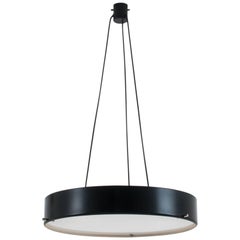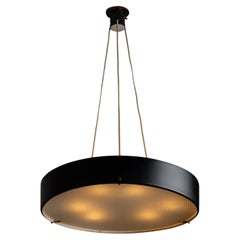Gatta 1090
Recent Sales
Vintage 1950s Italian Mid-Century Modern Chandeliers and Pendants
Aluminum
Vintage 1950s Italian Mid-Century Modern Chandeliers and Pendants
Aluminum, Steel
20th Century European Mid-Century Modern Chandeliers and Pendants
Aluminum, Nickel
20th Century Italian Mid-Century Modern Chandeliers and Pendants
Metal, Nickel
Bruno Gatta for sale on 1stDibs
Milanese lighting designer Bruno Gatta is best known for having founded a legendary postwar lighting manufacturer that produced some of the most innovative and inspiring fixtures of the 20th century during its short lifespan. The Italian company Stilnovo stayed true to its roots by making everything within the country and enlisting a slew of notable designers from the region to create pieces, such as Ettore Sottsass, Antonio Macchi and Joe Colombo.
Though Gatta founded Stilnovo way back in 1946, it is still one of the most instantly recognizable names in lighting. Like many European creatives designing furniture and decor in the wake of World War II, Gatta — an alum of visionary electronics maker Olivetti — leaned toward the new wave of mass-market and streamlined styles. In fact, Stilnovo loosely translates to “new style” in Italian, and vintage Stilnovo chandeliers, floor lamps and other lighting have endured as a practical choice for those looking to bring expressive and forward-thinking design into their homes.
Soon after Stilnovo was established, Gatta’s lighting fixtures were applauded throughout Europe for their novel industrial materials as well as their unique yet functional shapes. Italy during the mid-20th century was completely revolutionary, and Gatta and Stilnovo’s head designer, Angelo Gaetano Sciolari, helped shape the era.
When the 1960s arrived, Stilnovo was experiencing such a boom that the company opened a new production plant in Lainate. One of the brand’s most famous pieces, Giovanni Luigi Gorgoni’s quirky 1965 Buonanotte spherical table lamp, became a best seller.
Gatta partnered with some of the most well-known names in design, including Sottsass, Achille and Pier Giacomo Castiglioni, Colombo and Gae Aulenti. Sottsass’s pieces for Stilnovo, including the 1977 Valigia four-legged table lamp, the 1968 Lampros chandelier and Manifesto ceiling light, and the Castiglionis’ 1957 Saliscendi pendant light fixtures are some of the brand’s most recognizable to date. In 1978, De Pas, D’Urbino and Lomazzi designed the Fante lamp with an adjustable reflector that playfully recalls a broad-brimmed hat.
Stilnovo’s designs, including Danilo and Corrado Aroldi’s flexible Periscope table lamp, were featured in the 1972 exhibition “Italy: The New Domestic Landscape” at the Museum of Modern Art. While Stilnovo continued to operate with new designer collaborations after Gatta’s death, it closed its doors in 1988.
Italian art director Massimo Anselmi acquired the company in 2012 and rereleased several of Stilnovo’s most celebrated pieces. Then in 2019, lighting giant Linea Light Group purchased Stilnovo and relaunched its classic designs with contemporary touches like LED lighting systems.
Find vintage Bruno Gatta chandeliers, wall lights, table lamps and other fixtures on 1stDibs.
A Close Look at mid-century-modern Furniture
Organically shaped, clean-lined and elegantly simple are three terms that well describe vintage mid-century modern furniture. The style, which emerged primarily in the years following World War II, is characterized by pieces that were conceived and made in an energetic, optimistic spirit by creators who believed that good design was an essential part of good living.
ORIGINS OF MID-CENTURY MODERN FURNITURE DESIGN
- Emerged during the mid-20th century
- Informed by European modernism, Bauhaus, International style, Scandinavian modernism and Frank Lloyd Wright’s architecture
- A heyday of innovation in postwar America
- Experimentation with new ideas, new materials and new forms flourished in Scandinavia, Italy, the former Czechoslovakia and elsewhere in Europe
CHARACTERISTICS OF MID-CENTURY MODERN FURNITURE DESIGN
- Simplicity, organic forms, clean lines
- A blend of neutral and bold Pop art colors
- Use of natural and man-made materials — alluring woods such as teak, rosewood and oak; steel, fiberglass and molded plywood
- Light-filled spaces with colorful upholstery
- Glass walls and an emphasis on the outdoors
- Promotion of functionality
MID-CENTURY MODERN FURNITURE DESIGNERS TO KNOW
- Charles and Ray Eames
- Eero Saarinen
- Milo Baughman
- Florence Knoll
- Harry Bertoia
- Isamu Noguchi
- George Nelson
- Danish modernists Hans Wegner and Arne Jacobsen, whose emphasis on natural materials and craftsmanship influenced American designers and vice versa
ICONIC MID-CENTURY MODERN FURNITURE DESIGNS
- Eames lounge chair
- Nelson daybed
- Florence Knoll sofa
- Egg chair
- Womb chair
- Noguchi coffee table
- Barcelona chair
VINTAGE MID-CENTURY MODERN FURNITURE ON 1STDIBS
The mid-century modern era saw leagues of postwar American architects and designers animated by new ideas and new technology. The lean, functionalist International-style architecture of Le Corbusier and Bauhaus eminences Ludwig Mies van der Rohe and Walter Gropius had been promoted in the United States during the 1930s by Philip Johnson and others. New building techniques, such as “post-and-beam” construction, allowed the International-style schemes to be realized on a small scale in open-plan houses with long walls of glass.
Materials developed for wartime use became available for domestic goods and were incorporated into mid-century modern furniture designs. Charles and Ray Eames and Eero Saarinen, who had experimented extensively with molded plywood, eagerly embraced fiberglass for pieces such as the La Chaise and the Womb chair, respectively.
Architect, writer and designer George Nelson created with his team shades for the Bubble lamp using a new translucent polymer skin and, as design director at Herman Miller, recruited the Eameses, Alexander Girard and others for projects at the legendary Michigan furniture manufacturer.
Harry Bertoia and Isamu Noguchi devised chairs and tables built of wire mesh and wire struts. Materials were repurposed too: The Danish-born designer Jens Risom created a line of chairs using surplus parachute straps for webbed seats and backrests.
The Risom lounge chair was among the first pieces of furniture commissioned and produced by legendary manufacturer Knoll, a chief influencer in the rise of modern design in the United States, thanks to the work of Florence Knoll, the pioneering architect and designer who made the firm a leader in its field. The seating that Knoll created for office spaces — as well as pieces designed by Florence initially for commercial clients — soon became desirable for the home.
As the demand for casual, uncluttered furnishings grew, more mid-century furniture designers caught the spirit.
Classically oriented creators such as Edward Wormley, house designer for Dunbar Inc., offered such pieces as the sinuous Listen to Me chaise; the British expatriate T.H. Robsjohn-Gibbings switched gears, creating items such as the tiered, biomorphic Mesa table. There were Young Turks such as Paul McCobb, who designed holistic groups of sleek, blond wood furniture, and Milo Baughman, who espoused a West Coast aesthetic in minimalist teak dining tables and lushly upholstered chairs and sofas with angular steel frames.
As the collection of vintage mid-century modern chairs, dressers, coffee tables and other furniture for the living room, dining room, bedroom and elsewhere on 1stDibs demonstrates, this period saw one of the most delightful and dramatic flowerings of creativity in design history.
Finding the Right chandeliers-pendant-lights for You
Chandeliers — simple in form, inspired by candelabras and originally made of wood or iron — first made an appearance in early churches. For those wealthy enough to afford them for their homes in the medieval period, a chandelier's suspended lights likely exuded imminent danger, as lit candles served as the light source for fixtures of the era. Things have thankfully changed since then, and antique and vintage chandeliers and pendant lights are popular in many interiors today.
While gas lighting during the late 18th century represented an upgrade for chandeliers — and gas lamps would long inspire Danish architect and pioneering modernist lighting designer Poul Henningsen — it would eventually be replaced with the familiar electric lighting of today.
The key difference between a pendant light and a chandelier is that a pendant incorporates only a single bulb into its design. Don’t mistake this for simplicity, however. An Art Deco–styled homage to Sputnik from Murano glass artisans Giovanni Dalla Fina (note: there is more than one lighting fixture that shares its name with the iconic mid-century-era satellite — see Gino Sarfatti’s design too), with handcrafted decorative elements supported by a chrome frame, is just one stunning example of the elaborate engineering that can be incorporated into every component of a chandelier.
Chandeliers have evolved over time, but their classic elegance has remained unchanged. Not only will the right chandelier prove impressive in a given room, but it can also offer a certain sense of practicality. These fixtures can easily illuminate an entire space, while their elevated position prevents them from creating glare or straining one’s eyes. Certain materials, like glass, can complement naturally lit settings without stealing the show. Brass, on the other hand, can introduce an alluring, warm glow. While LEDs have earned a bad reputation for their perceived harsh bluish lights and a loss of brightness over their life span, the right design choices can help harness their lighting potential and create the perfect mood. A careful approach to lighting can transform your room into a peaceful and cozy nook, ideal for napping, reading or working.
For midsize spaces, a wall light or sconce can pull the room together and get the lighting job done. Perforated steel rings underneath five bands of handspun aluminum support a rich diffusion of light within Alvar Aalto's Beehive pendant light, but if you’re looking to brighten a more modest room, perhaps a minimalist solution is what you’re after. The mid-century modern furniture designer Charlotte Perriand devised her CP-1 wall lamps in the 1960s, in which a repositioning of sheet-metal plates can redirect light as needed.
The versatility and variability of these lighting staples mean that, when it comes to finding something like the perfect chandelier, you’ll never be left hanging. From the whimsical — like the work of Beau & Bien’s Sylvie Maréchal, frequently inspired by her dreams — to the classic beauty of Paul Ferrante's fixtures, there is a style for every room. With designs for pendant lights and chandeliers across eras, colors and materials, you’ll never run out of options to explore on 1stDibs.

